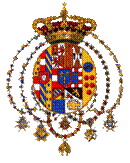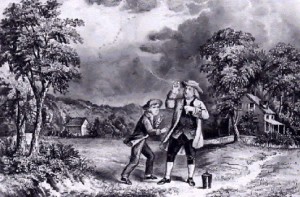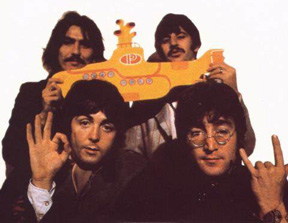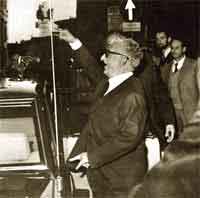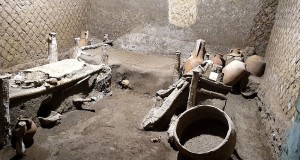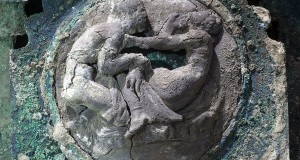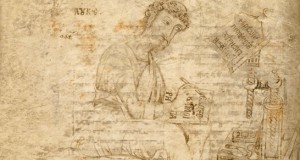
Salvatore Fergola – Inauguration of railway line Napoli-Portici, 1840 – San Martino Chartusian Monastery Museum, Naples

by Rita Guastamacchia
In the beginning was the railway section Naples- Portici, first italian train, inaugurated by the king Bourbon with great solemnity in October 3, 1839. In 1840 the railway arrived in Torre del Greco and in 1842 in Castellammare. The works was continued to install the railway in Nocera, and was stopped in 1844. A second railway line, funded directly by the State, reached Capua in 1843 and Caserta in 1844. In 1853 was awarded a contract for the construction of railway line Nola – Sarno -San Severino , which would have to continue up to Avellino. The program included then the railway line Naples-Capua reached Cassino joining the railway of Papal States. The Naples – Avellino line would have to go to Bari, Brindisi, Lecce, Taranto and, in a different direction, to region Basilicata. They was to plan also the railway lines to Reggio Calabria and that from Pescara to Tronto. In Sicily was planned the lines Palermo-Catania-Messina and Palermo-Girgenti-Terranova. In short, big projects and high expectations …but at the time of Italy unification, in the Southern Italy the extension of the railway line was still only 184 km , all concentrated in Campania, while the central-northern Italy had now made the great leap forward. The lovely article of Rita Guastamacchia will deal in particular with the Apulia railway lineand his bizarre failed construction. We welcome Rita on FAME DI SUD (Fds editorial staff) .
Last famous words of King: “This railway no doubt will benefit to trade and, considering how this new road is to be useful to my people, I enjoy much more in my thinking that when the works will be completed up to Nocera and Castellammare, I can see them soon continued up to Avellino and Sea Adriatic coast“(Ferdinand II of Bourbon, during the inauguration of the Naples-Portici)
by Rita Guastamacchia
“It’s a truth universally acknowledged”, that Southern Italy people is often taken by a singular illness: chronic superstition. Here is an example with so much of crown and horns!
It’s not a fairy tale, it’s history.
In the far 1855, the beautiful, fascinating engineer Emanuele Melisurgo, from Bari, Apulia, made the advanced project of a railway net through Puglia region. Seductive in his power of belief, he presented the project to Ferdinando the 2nd of Borbone, king of the Two Sicilies. Many times Mr Melisurgo obstinately looked for to induce the king to build the railway, but every time the sovereign stopped him by a pair of horns.
 “Va’, vattenne, si no faccio comme ‘e femmene, te dico de sì!” “Go, go away, otherwise I’m sure I’m going to say you “yes”, like a whore”, answered the king, in Naples dialect.
“Va’, vattenne, si no faccio comme ‘e femmene, te dico de sì!” “Go, go away, otherwise I’m sure I’m going to say you “yes”, like a whore”, answered the king, in Naples dialect.
Melisurgo didn’t surrender, the project was launched, but “unfortunately” the forecasts to pick up capitals from the provinces of the Kingdom miserably failed. Melisurgo foresaw that at least 55.000 citizens would have bought the shares for the project, considering the number of towns of the area that would have had to take advantage by the passage of the railway net. But only 1000 citizens subscribed the shares.
The first stone of the railway remained just the first one and no more.The project failed falling down against a forest of “horns” that raise on the face of Melisurgo.
Who was the guilty? Melisurgo wanted to challenge the fate, that had bewitched him in the person of the most famous jettatore, “hoodoo”, of the Kingdom of the Two Sicilies:
 Ladies and Gentlemen, protect you against the evil eye with a pair of horns, it was the Duke of Ventigliano.
Ladies and Gentlemen, protect you against the evil eye with a pair of horns, it was the Duke of Ventigliano.
If we look at the anecdotes of the way of life of Naples and its Provinces, particularly Puglia, in the past centuries, the history of the hoodoos and their victims is wound in a comic atmosphere.
The famous historian,journalist and politic man Raffaele De Cesare (1845-1918), born in Spinazzola, one of the biggest agricultural towns of Apulia, painted the figure of Don Cesare of the Valley, Duke of Ventigliano as follows.
Everyone trembled when The Duke began to speak. King Ferdinando the 2nd too, he could not refuse to invite the Duke at court, but certainly every time that he was in matter some calamity was in trap. And definitely as in the case of the Railway of Apulia, in which he said not to believe,
As usuall, Ventigliano guessed. Apulian engineers boycotted the project.
And the legal consequences related to the failure of Melisurgo were so big that even his child had to suffer for the bankrupt of his father. Probably after the regrettable event the irreducible engineer will have had to attribute more credit to superstition
 And you? Are you reluctant sitting to table when you are the thirteenth one (in Italy bad luck)?
And you? Are you reluctant sitting to table when you are the thirteenth one (in Italy bad luck)?
Do you touch the keys or other things, as wood, when you meet an empty hearse?
Do you change your way when an innocent black cat is crossing the road? But if you don’t use any of such precautions and still something goes wrong, who is the guilty ? The bad fate?
Well. You are not alone. You are predictably victims of a Southern heritage that it is still hard to die.
Superstition, from its high forms of cults and rituals, to those of popular beliefs in the hoodoo, has been object of study and amenity, recorded by the chronicles of every time.
The famous journalist A. Diotallevi wrote on “Il Messaggero” newspaper , to the eve of the Great War: “Superstition is like the chain to the foot of the jailbirds. When the convicts went out of the prison, they continue to drag the foot as if the chain is still attached.”
Also Southern people preserve superstition as wound of the soul, contracted in the far past .
This is Mediterranean heritage of this land along the sea, also if sometime there are people from Milan who try to be more superstitious than us.
I’m a bit afraid to pronounce this “word” for an “old man” as Mr Silvio Berlusconi (whose name has became taboo from day to day, like someone before whom men hide their face). He himself many times stopped his colleagues with a pair of horns …. But recently no horn got him protection against the judges and even against part of his own group.
With another enphasis and cultural support the anthropologist Ernesto De Martino landed to the same conclusions in his studies devoted to the magic phenomena, from South and Magic to The earth of the remorse, on the phenomenon of the tarantism in Southern Puglia, in Salento, the ritual care of the bite of the mythical “taranta.”
But perhaps for that heritages of which above, we like to exorcize the fear laughing.
And we touch iron (as you touch wood) or arise …
But why the horns, or better, the horn? Because the horn is nothing but a point, and through the points the vital strength of the man holds him to neutralize the strength emanated from the feared hoodoo. As it happens for the lightning-rod, which attracts and unloads the energy of the lightning to neutralize the discharges emanated during the storms. Fingers are nothing else but stings.
Superstition however it is not only an escape to protect against the lightning of witches, wizards and hoodoos, it means also to look for talismans as mascot. And I like to wish you a good luck, giving you an ideal small bundle of white little flower, that born spontaneously in the Scottish moors: the white heather, so much dear once to English gentlemen, who didn’t go out without bringing some flower of it to the buttonhole.
From Scotland wagons of heather departed for the whole United Kingdom, and till the beginning of last century around this nice habit a flourishing commerce was created. For the roads in London the sellers of heather shouted: “White Scotch Heater, very good luck.”
Today gentlemen seem to be a race no more surviving, and not only in UK. And there is nobody who still know and believe in the language of the flowers. What a pity, but I persist to say, opposite to every superstition:
it’s true, but I don’t believe it yet.
 Fame di Sud Il sud Italia come non lo avete mai visto
Fame di Sud Il sud Italia come non lo avete mai visto
